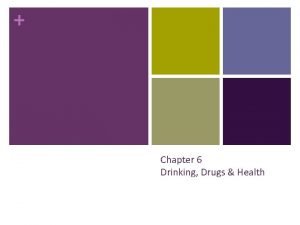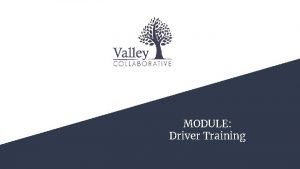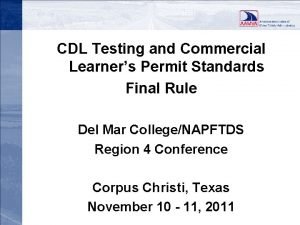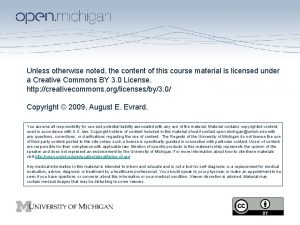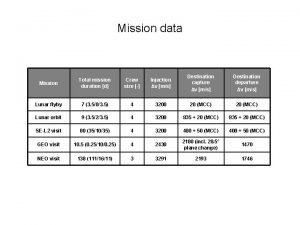May 2014 Announcements May 8 2014 Mission Driving











































- Slides: 43

May 2014 Announcements May 8, 2014

Mission Driving Business Value Through Developing IT Service Management Professionals http: //itsmfusa. org/about-us





7


Introducing 2013 Leadership Team l 2014 Leadership Team: – – – – – Cathy Kirch- President TBA- President Elect Chi Le- Membership Gwen Pulka Secretary Tom Herrmann- Communications Nori De Jesus- Events Chair Terry Brown, Sue Rudman - Events Committee Volunteers are welcome! Elections will be held in October

LIG News l Chicago Land LIG 2014 Plan of events March 6 Motorola Robyn Borough May 8 l T Fruition Tim Currie & Barry Brooks August 7 United October 2 Allstate TBD Malcolm Fry Target is 4 meetings a year, the first Thursday of the month. 2015 planning will begin in October

Go l for Chicago it. SMF LIG Join the Linked In group for Chicago it. SMF LIG and get connected.

LIG News l Chicago Land LIG Thank You – Thank you to our sponsors l Fruition Partners l Service. Now

ITSM Continuous Service Improvement From Snake Oil, to Operations, to Value

Agenda • Some juicy examples of snake oil IT metrics • Making ITSM Metrics Operational • Service Improvement, Making the transition from Operations to Value Snake oil is a traditional Chinese medicine made from the Chinese water snake (Enhydris chinensis), which is used to treat joint pain. However, the most common usage of the phrase is as a derogatory term for quack medicine. The expression is also applied metaphorically to any product with exaggerated marketing but questionable and/or unverifiable quality or benefit.

l l Tim Currie @the. ITSMguy l Regional Vice President, Fruition Partners Certified ITIL V 2 Service Manager and V 3 Expert, ISO 2000 Professional Senior ITSM consultant with over 20 years of experience. Former Director of Service Management at Fermi National Accelerator Laboratory (http: //www. fnal. gov) in Batavia, IL. Responsible for leading ISO 20 K Certification Project at Fermilab.

Fruition Partners by the Numbers 10 YEARS OF CLIENT GROWTH 5 YEAR Service. Now Partnership and Only Partner Exclusive to Service. Now 900+ 100+ SERVICENOW INTEGRATIONS VOIP/ TELEPHONY REMOTE SUPPORT APPLICATION CONNECTORS SHIPMENT TRACKING 600+ #480 #12 Premiered at #480 on Inc. 5000 Fastest Growing U. S. Companies Premiered at #12 on Inc. Magazine’s List of U. S. Top Job-Creating Companies in IT Industry #15 Service. Now Projects Clients Premiered at #15 on Brill Street’s “Top Employer in Chicago for Gen Y” ASSET MANAGEMENT SECURITY MANAGEMENT 69 CERTIFIED SYSTEM ADMINISTRATORS 55 CERTIFIED IMPLEMENTATION SPECIALISTS 4000+ ITIL Certifications 400+ Service. Now Go Lives

“Numbers don’t lie” • More and more focus on metrics in IT ü Good for governance, good for managing ü Managing = using and interpreting metrics and acting accordingly • Metrics are objective numbers, not subject to interpretation ü Hard facts, devoid of any subjectivity ü After all, "numbers don't lie. ” Right? • Metrics are important ü Internal metrics can lead to major decisions (investments, outsourcing) ü When outsourcing, metrics can have contractual consequences There are three types of lies: lies, damn lies, and statistics – Benjamin Disraeli

Amazon’s 99. 95% Amazon’s SLA for EC 2 is 99. 95% for multi-AZ deployments. That means that you should expect that you can have about 4. 5 hours of total region downtime each year without Amazon violating their SLA. In April 2011, persistent storage (EBS) linked to the EC 2 virtual servers went down. Amazon didn't break its 99. 95 percent uptime service level contract with its EC 2 customers. Why? Because the EC 2 service was available. The data wasn't. Gotcha! http: //blogs. gartner. com/lydia_leong/2011/04/21/am azon-outage-and-the-auto-immune-vulnerabilities-ofresiliency/

Glorious FCR First Call Resolution (FCR) is being touted by outsourcing service providers as the standard and most important metric for Service Desks. Some outsourced Service Desks are being paid by the ticket. However, the FCR metric may be a deceptive metric as it may indicate your Service Desk is "getting better and better” … at fixing the same issues over and over again. FCRs can indicate deficient Problem Management: recurring incidents are not eliminated and become easy and fast resolution targets for the Service Desk.

“F” as in Failure or Fools Theory, in the books Practice, in the contract* * Contract between 2 Fortune 1000 companies

Airport Printers A Midwest airport outsourced its baggage handling system in 2011 and had a service level in place that 95% of all luggage tags would be correctly read. It was hoped that airlines use quality printers to print readable tags. One airline had a 20% reading rate, as they were using an Epson MX-80 dot matrix printer. Metrics can have undiscovered dependencies. Failing metrics may have unexpected causes. Hope is not a strategy

Deception or Ignorance? • Most of the time, the origin of poor metrics is ignorance and lack of focus on the purpose of the metrics • Reports do not add value, unless followed by corrective action • Metrics need to be relevant (e. g. , what does it mean to have a 30% MTTR improvement? ) and take into account dependencies • Metrics need to focus on the value for the reporting recipients and their goals • Metrics deserve a lot of thought! “It's not because you are not paranoid, that they are not trying to get you. ”

Medicine - 1 Ensure the metrics fit your goals: • Metrics cost money and time • Metrics without follow-up do not provide value to the organization • Metrics need an owner who is accountable for corrective action (See ISO 20000 “Shalls”) Focus on what you are trying to achieve! No metrics for the sake of metrics

Medicine - 2 Think about your metrics in terms of layers (operational, tactical, strategic) and build your reporting in a "pyramid". Lower level metrics feed into higher level metrics. Operational metrics are not necessarily understood at the strategic level. Different levels use different messaging. Ensure the communication of the right metric through the right channel at the right time

Medicine - 3 Make sure you understand exactly how a particular metric is calculated: • Ask for examples and include them in the contract • Ensure procurement groups confer with IT about the outsourcing contracts metrics • Ensure every metric is properly defined • (Again) Ensure every metric has an owner!

Medicine - 4 Metrics can have a psychological impact • Measuring performance or productivity Metrics can have a financial or legal impact • Penalties in outsourcing contracts • Impact on bonus (e. g. , based on FCR metrics) Ensure you understand the hurdles and the impact of the metrics

Medicine - 5 • Split the metrics into content and reporting ü Content = focus on the actual content of the metric; data gathering ü Reporting = focus on what / how / from and to whom / when / why and adjust content accordingly; conveying information, not data! ü Similar to marketing (features vs. benefits) • Spend time to brainstorm the content of your dashboards, calculations, presentations ü Many dashboards are "smoke and mirrors" ü Automate as much as possible to lessen workload (e. g. , FP SN add-on tool Mirror 42/Perfromance Analytics) ü Decide “push” (send reports) vs. “pull” (make reports available)

“Numbers do lie” • Focus on an end-to-end understanding of your service lifecycle and process (DIKW): ü ü ü Problem Management metrics (reduce the probability of bleeding) probably more important than Incident Management (stop the bleeding) Understanding contradicting or dependent metrics (e. g. , number of emergency changes and incidents) Bridging demand capacity management • Beware of trivializing the task of choosing, reporting, and interpreting metrics. After all, "numbers do lie. ”

Metrics in ITSM …Enabling Change In highly successful change efforts, people find ways to help others see the problems or solutions in ways that influence emotions, not just thought. – John Kotter, author of ‘Leading Change’

ITSM It Starts with Change l 80% of outages result from change l 80% of change-related outages due to unplanned / poorly managed change l 80% of Mean Time to Resolve (MTTR) spent diagnosing source of change and correcting impact Source: HDI (Help Desk Institute)

ITSM Focus on Meaningful Capability In mature ITSM operations, Incident Volumes Should Decrease: True of False? In mature ITSM operations, Incident Volumes Should Decrease: Relative to: Ø Change Ø Enhancements and New Systems Deployed Ø Value Delivered

ITSM Capabilities into Value Problem Management: Ø Volume / % of Known Errors Removed from the Infrastructure Change Management: Ø Volume / % of Change for Incident/Problem Resolution Ø Volume / % of Change for Enhancement Delivery Ø Volume / % of Change for Net New Service Provisioning Ø Relative Incident to Change Ratio (Quality) Request Management: Ø Volume / % of Standard Requests Fulfilled Ø Volume of Non-Standard Requests Fulfilled (by Customer by Service) 32

Metrics in Service Delivery …

Unfunded / Unplanned Projects CMM – 3 Defined Operations Work Stuff ~ 80% of Effort & Cost CMM – 2 Repeatable CMM – 1 Ad hoc CMM – 0 Absent ITSM Maturity - Origins Request Standard Request “P”- Projects Break/Fix “p”- Projects Maintain Service Non-Standard Request

ITSM Maturity - Origins SERVICE Standard Request Non-Standard Request Maintain Service “p”- Projects “P”- Projects • Availability /Capacity • Continuity / Security • Service Level Performance • Service Costing • Budget Forecast • Service Improvement Hidden Cost / Hidden Value

CSIP: ISO 2000 Perspective (abridged) Process “SHALLS” Ø Every process SHALL have an accountable owner Ø Every process SHALL be documented Ø Every process SHALL have documented performance metrics and KPIs Ø Every process SHALL be measured against performance metrics and KPIs Ø Every process SHALL be have a plan for monitoring and improvement Service “SHALLS” Ø Every Service SHALL have an accountable owner Ø Every Service SHALL be documented/defined Ø Every Service SHALL have documented performance metrics and KPIs Ø Every Service SHALL be measured against have metrics and KPIs Ø Every Service SHALL be have a plan for monitoring and improvement

CSIP: ISO 2000 Perspective (abridged) PLAN: 1. Establish Objectives / Purpose 2. Assess Capability 3. Assess Constraints / Risk to Performance 4. Establish Measures 5. Take Action (or not) CSIP / Plan Review: 1. Review Performance 2. Assess Constraints / Risk to Performance 3. Review/Revise Measures 4. Take Action (or not)

What about Portfolio? . . What about Portfolio the SLA? …

Service Portfolio & Availability…a love story Service Areas generally also map to Departments, and are governed by a general purpose SLA/OLA Service Offerings Roll up to service area, and specific SLAs/OLAs

Service Offerings and Availability • • • Availability Charts drove the “Service Offering ” definition and created a de facto Service Catalog (as opposed to the academic ITIL exercise) Availability metrics drove the “Service Level” discussion, and made SLA/OLA commitments a reality. With executive support, a tedious and sometimes contentious exercise became a foundation for automation.

ITSM Focus on Meaningful Capability As processes are improved through CSIP and grow in maturity, subsequent processes will be better enabled, adopted, and improved. The result is a cumulative improvement in overall process maturity, service delivery, and alignment with the business. This maturation is proportional to the commitment Of management and the dedication to CSIP. CMMI / Maturity 5 4 3 2 Change Configuration Incident Request Problem 1 Service Level Time / Maturity • Capacity • Availability • Continuity

info@fruitionpartners. com /Fruition. Partners @Fruition. Partners /company/fruition-partners

Thank You Tell a colleague or friend about it. SMF USA Invite them to the next LIG meeting to connect with peers, learn from industry experts, grow their knowledge and advance in their career.
 What does montag hear in the seashell
What does montag hear in the seashell Pvu background
Pvu background Potentiial
Potentiial R/announcements
R/announcements General announcements
General announcements Church announcements
Church announcements Hci design patterns
Hci design patterns Golf lessons palmerston north
Golf lessons palmerston north Driving force
Driving force Drivers ed module 7 topic 4
Drivers ed module 7 topic 4 What is driving the market today
What is driving the market today A motorist should know that he she is entering
A motorist should know that he she is entering While driving in the city the busy urban
While driving in the city the busy urban Oea driving strategy
Oea driving strategy Copyright
Copyright Irlen syndrome driving
Irlen syndrome driving Introduction to seminar
Introduction to seminar Drugs that affect basic driving skills are
Drugs that affect basic driving skills are Kturn
Kturn You are the driver chapter 1 answer key
You are the driver chapter 1 answer key Driving age by state
Driving age by state Driving module
Driving module Ptit safe driving and awareness course online
Ptit safe driving and awareness course online New jersey drivers manual
New jersey drivers manual Drafting driving
Drafting driving Chapter 15 alcohol other drugs and driving
Chapter 15 alcohol other drugs and driving Traffic controls help you to travel safely by *
Traffic controls help you to travel safely by * Tida challenge driving
Tida challenge driving The space between traffic clusters is called a(n)
The space between traffic clusters is called a(n) 20 question questions
20 question questions Searching for specific driving-related clues
Searching for specific driving-related clues In urban traffic you should look
In urban traffic you should look Examples of testing tools
Examples of testing tools Maine driving dynamics
Maine driving dynamics Holding tools classification
Holding tools classification Uuu i driving in the night
Uuu i driving in the night Chapter 10 activity 10-1 drivers ed
Chapter 10 activity 10-1 drivers ed Spider method driving steps
Spider method driving steps Road test scoring sheet
Road test scoring sheet Driving force
Driving force K turn
K turn You are driving down the road
You are driving down the road Driving mass
Driving mass Projectile drivers ed
Projectile drivers ed

















